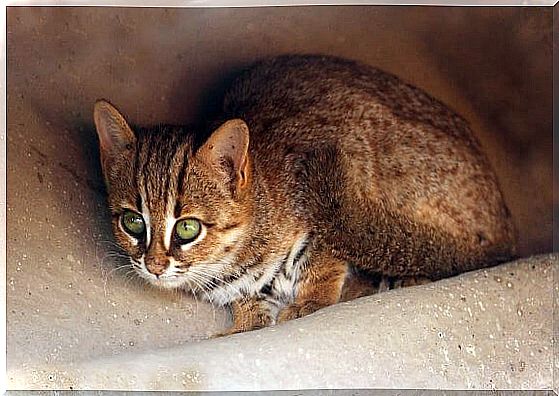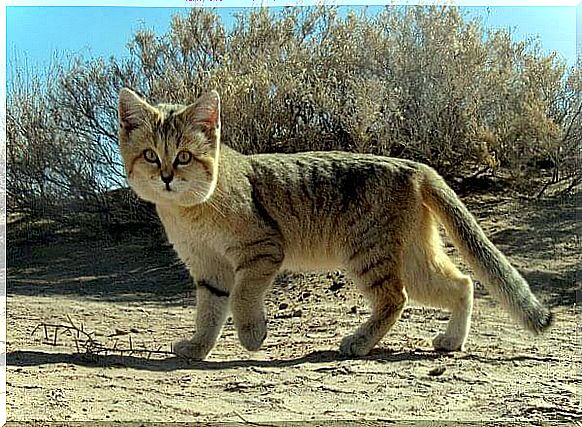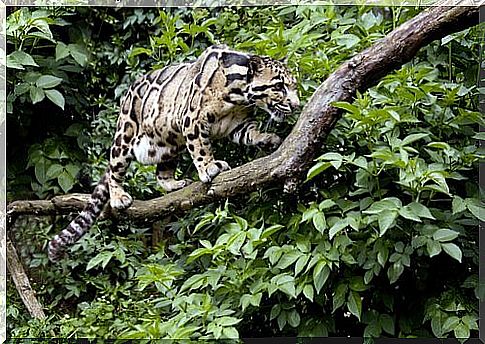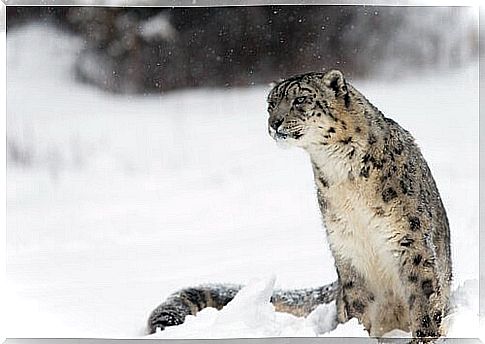Little-known Wild Cats

When we think of wild cats, lions, bengal tigers or leopards come to mind. The truth is that, of the 38 species of wild cats that exist, 31 are considered small cats, some as small as domestic cats.
Cats are extraordinary creatures, but they are also threatened. Almost everyone faces some degree of danger in nature and their numbers are dwindling. All this due to poaching and destruction of their ecosystems.
Below, we’ll mention some of the lesser-known wild cats on the planet:
rust cat
It is the smallest wild cat on Earth, with a length of 35 to 48 centimeters and a weight between 900 g and 1.5 kg.
The fur of the rust cat (picture that opens this article) is short and gray over most of the body, with rust-colored patches on the back and sides.
Another of its distinguishing features is that it has a white belly with large dark spots, and its tail is darker in color, reaching around the middle of its body.
It has six dark bands on each side of the head, which extend over the cheeks and forehead.
They inhabit the rainforests of Sri Lanka and southern India. It is in danger of extinction due to the loss of its habitat, which is gradually being replaced by agricultural land.
desert cat
The desert cat reaches 50 centimeters in length between head and body and 30 centimeters in tail. The biggest males do not reach 3.5 kilos in weight.

The fur is sandy in color with a few darker stripes, more developed in the African subspecies, and only easily visible on the upper part of the forefeet. The tip of the tail is also dark in color.
This is the feline best adapted to sandy deserts. Their head is remarkably wide and their ears are wide, which improves their hearing and facilitates heat loss.
It lives in the deserts of the Sahara, Egypt, Arabia, Pakistan, Afghanistan, Iran, Jordan, Syria, Iraq and some parts of Asia.
It is even found in the Karakum Desert, where the temperature can reach 80°C and drop to -25°C. This feline is on the list of endangered species whose hunting is prohibited in many countries.
pallas cat
It is similar in size to a domestic cat, between 46 and 65 centimeters in length, with a tail that measures between 21 and 31 centimeters in length. Its weight ranges from 2.5 to 4.5 kilos.

Its abundant coat protects it from excessive cold and wind and is ocher with dark vertical stripes on the trunk and forefeet.
During winter, their coat is grayer and has fewer stripes than in summer. It has black rings on its tail and dark spots on its forehead. Cheeks are white, with narrow black stripes.
These cats take refuge in caves, between cracks in the rocks or in the burrows of marmots. They only go out in the afternoon to hunt small mammals.
It inhabits the steppes of Mongolia, Siberia and Tibet, at altitudes reaching 5,000 meters. This species is threatened by the destruction of its habitat, the reduction of its prey and by hunting.
the Andean cat
Also known as the lynx cat, the Andean cat is the most endangered species in the Americas. They are small, robust, gray or brown cats, with vertical stripes on the upper back, patches on the sides and circles around the tail and legs.
Measures between 60 and 80 centimeters, plus the tail, about 35 centimeters, and weighs between four and seven kilos.

The Andean cat is native to South America. Its distribution is limited to the Andes, Peru and northern regions of Bolivia, Chile and Argentina.
It lives in areas of not very high or dense vegetation, as well as in steppes and rocky areas. It lies 3,000 to 5,000 meters above sea level, above the tree line.
Although it only lives in high mountain areas, the valleys inhabited by humans act as barriers, which considerably fragment its population.
They are generally hunted in Chile and Bolivia for superstitious reasons.
cloudy leopard
The clouded leopard is a medium-sized feline with a robust frame (length from 60 cm to 1.1 meters and weight from 11 to 65 kg), with short legs and a very long tail.
Its tail serves to maintain balance and its legs are perfect for climbing trees; the hind legs are longer than the front legs.

These cats are threatened by the loss of their habitat, caused by deforestation and illegal hunting. It is suspected that fewer than 10,000 adult specimens exist today.
The fur has large irregular patches with a black edge and a brown interior, which helps it to camouflage itself in vegetation.
Their name comes precisely from these dark and elliptical points, which gives them a slight resemblance to clouds.
It lives east of India, south of China and Indochina. They can be found in varied ecosystems, both in mountainous areas, which exceed 2,000 meters in height, as well as in swampy areas and coastal mangroves.
Snow Leopard
The snow leopard is found in mountainous areas of Siberia, Russia, Pakistan, Mongolia, Tibet, India, Nepal or Uzbekistan.
These leopards live in remote mountains, at altitudes of up to 6,000 meters above sea level.

Although it is smaller than other large predators, it can reach 75 kilos. It has a robust and short body, with a long tail compared to other cat species.
This feline is perfectly adapted to living in the cold, with a compact body covered with a thick layer of fur.
In addition, it has small furry ears and wide claws that act like snowshoes, similar to those of a polar bear.
Its coat is thick and in different shades of gray, with black spots and a white chest, as well as a yellow or brown gradation in some parts of the body.
The last snow leopards are in danger of extinction due to poaching and climate change. Currently, it is estimated that there are only between 4,000 and 9,000 copies of this leopard species.
The wide variety of wild cats
As evidenced by this small sample, felines are mammals that have a wide morphological variety.
There are wild cats the size of a St. Bernard dog and others as small as a house cat. Its coloration is also extremely varied, ranging from dark to very light colors.
This variety is the product of the adaptation of these fantastic animals to the different ecosystems of the world.
Wild cats are animals that deserve all our attention to be preserved.
This is because many of them are in danger of extinction due to habitat destruction and illegal hunting.









